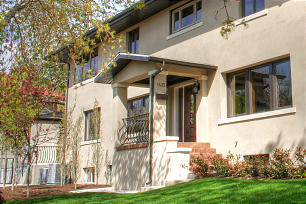By Ann Robinson and Annie Schwemmer
Well, summer finally came, and more hot days are in the forecast.
While most Utahns have some sort of cooling system in their homes, some yearn for a system upgrade.
Here is a basic primer on air conditioning systems:
A challenge of adding central air to a home is finding an inconspicuous location for the condenser. There are two types of central air systems.
Although central air conditioning and air conditioning are indeed both methods to cool the air, the two systems are not really the same.
Technically speaking, “air conditioning” refers to an air conditioning unit, a freestanding device or a device that is installed in the wall. Air-conditioning units are mobile refrigerating devices typically equipped with a blower that provides a continuous flow of cold, filtered air.
“Central air conditioning” is a complex system, typically installed when a building is constructed (but which can be retrofitted) that provides heating, cooling, filtering and ventilation as needed for the home.
The system uses supply and return ducts throughout the house to circulate cool air.
Your central air renovation should start with an Air Conditioning Contractors of America Manual J load calculation. A heating, ventilating and air conditioning (HVAC) contractor will perform this calculation to determine the heat gain of your home.
This lets the contractor know the proper size of your heating and cooling unit.
One of the most “green” steps you can take for your home is to make sure the HVAC system is sized correctly.
Typically, in lieu of actually making the calculation, contractors in the past have consistently oversized systems “just to be sure.” Any error in sizing the system — too large or too small — will result in wasting energy and money. An undersized unit won’t be able to cool rooms down completely on the hottest days and will cost more to operate because it has to run longer than a correctly sized unit. An oversized compressor also costs more to operate because it simply takes more electricity to run a bigger unit.
Air conditioning units are also given a seasonal energy-efficiency rating (SEER). This rating refers to the British thermal unit (BTU) which is a traditional unit of energy. It is approximately equal to the amount of energy needed to heat one pound of water one degree Fahrenheit. The SEER rates how many Btu’s an air conditioner will remove for each watt of electricity it consumes. The higher the SEER, the less it costs to operate.
Federal law requires that new A/C units have a SEER of at least 13. These units have lower operating costs, tend to be higher quality, have more safety features, better sound shields and lower voltage requirements. In general, the higher the SEER, the higher the initial cost for the unit and the lower the energy consumption.
There are two types of central air conditioning systems: split-system and packaged unit.
Split system central air conditioning is what we typically find in residential use in our area. It consists of a metal cabinet, located outdoors, which contains the compressor and condenser. The evaporator is located in a cabinet indoors, usually installed with the forced-air furnace. This type of system is considered the most economical choice.
In a package system, all of the components, which may also include heating coils or a furnace, are located in a single cabinet. The cabinet is located on the roof of the structure or on a concrete slab next to the structure’s foundation.
This is essentially a large wall air conditioner with ducts. This type of system is rarely used for residences in our area.
In a remodel scenario, the existing furnace ducts can be used for air conditioning. When added to an existing forced-air heating system, central air for a 2,000-square-foot home costs $3,500 to $4,000 and can be done by two technicians in two to three days, often with little or no change to the duct work.
If your main source of heating is a radiant system based on a boiler, there is no existing duct work in your home. If a house needs ducts, the costs and work time double for the installation, and walls and ceilings need to be altered to fit the new ducts into the existing layout.
A contractor experienced in retrofitting can hide ductwork behind walls, in the back of closets and up in the attic to help minimize the disruption to your home.
If, however, you are keeping your radiant heating system, rather than installing ducts throughout your house, consider other options, such as adding ductless mini-split air conditioners to strategic areas to cool your home.
If you take the impulse to upgrade to central air seriously, you may find it is easier and more cost-effective than you thought. It may even be the best renovation you do to your home — at least you”ll think it is in the summer!
P.S.: If you have central air conditioning, don’t forget to clean the filters on your exterior condensing unit. As always, we welcome your home architect design questions at ask@renovationdesigngroup.com.

